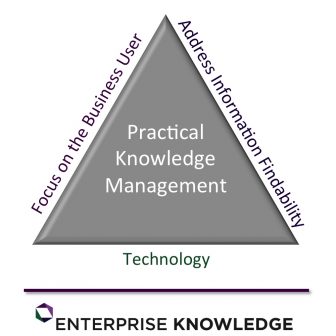Several years ago, I had the pleasure of writing an article for Inside Knowledge Magazine about the current state of knowledge management. Having come across the article recently, I thought it would be useful to provide an update on that piece.
I’d originally written that knowledge management (KM) had acquired something of a bad reputation. I attributed this to a couple of related issues. First, there was too much talk and too little action. Through my years of knowledge management consulting, I’d seen KM treated largely as an academic pursuit, with a great deal of research and discussion but very little practice. Hard return in investment and measurable success criteria were lacking in a lot of KM projects. A diminishing number of these ‘ivory tower KMers’ still haunt organizations around the world, with high-minded concepts introduced as initiatives, but often lacking measurable results and the requisite end user involvement.
Assessing today’s business environment, I see KM in practice having matured to a point of meaningful business value. KM practitioners and organizations have matured to the point where they are successfully leveraging KM principles in their business or are at least moving in that direction. In my view, there are three primary drivers for this maturation of KM.

1. Practical KM
First, organizations have realized what KM is and should be. KM is not an individual project, nor a discrete functional office. In order to be truly successful, KM must be integrated in the day-to-day operations of an organization. The most successful efforts with which I’ve been involved have all shared the same characteristics: support and understanding from management; clearly stated and commonly understood business value and goals; defined analytics to measure results; iterative approaches and governance to demonstrate progress and allow for adjustments; and, wide involvement by end users and other stakeholders. I often summarize all of these successful KM characteristics under the banner of ‘practical KM’. First and foremost, practical KM is about involving your business users actively at every point of KM strategy, design, implementation, and operations. Change management shouldn’t so much as a discrete activity in advance of rollout, it should happen as an integrated component during every step of an effort and beyond.
2. The Need is Clearly Defined and Ever-present
The second major driver for the successful maturation of KM is, simply, necessity. In today’s information age, the amount of content generated has moved from arithmetic to exponential growth. Only a decade ago, a relatively small set of business users were generating online content and even fewer were responsible for managing that content. However, with the democratization of content management and, more recently, ever-expanding social computing trends, anyone is a potential content publisher or manager. As a result, organizations are buckling under the weight of their own content. As more content is generated, it dilutes that which is truly critical to the business, creating issues with findability, and in turn yielding problems with worker productivity and user satisfaction. Organizations have realized the extreme cost of searching for content, not finding that which already exists, and re-creating content an organization already possessed. At the same time, as the baby boomers begin to retire, they are taking their tacit knowledge with them. This too results in a pressing need for KM, in order to capture that knowledge and ensure it remains with the organization that needs it.
3. Technology Supports KM
The third driver is technology. Many of today’s technologies have caught up with the information management theory that has influenced their development. For instance, a technology like Attivio offers the largely automated functionality to integrate structured and unstructured content, auto-tag it, and expose it to users via faceting and other intuitive mechanisms that enhance findability. Taxonomy management and content tagging tools have also made significant leaps forward, opening up the possibilities for all content within an enterprise to be consistently tagged, categorized and surfaced through navigation and search. Social computing tools, from Yammer to Jive, have created natural and intuitive ways for users to create, manage, and share a myriad of information, naturally converting tacit knowledge to explicit knowledge. Broadly stated, technologies are becoming easier to manage and integrate, meaning that an enterprise has both a greater need and a greater ability to manage its knowledge in a cohesive fashion. It should be noted, however, that technology was the last of the three drivers I listed. This was purposeful, as successful KM efforts will not be driven by technology, but instead will use it as a support or enabler.
As KM has experienced its ebbs and flows, it has also struggled with a lack of clear or consistent definitions. In summary, we offer the Enterprise Knowledge definition as “leveraging technologies in a practical manner to capture, manage, and present information in order to connect the right people to the information they need.” Through our deep experience in knowledge management consulting, we’ve seen first hand that when organizations actively adopt this definition and leverage the concepts of practical KM, they will flourish, as will the health and dynamism of the information they need in order to be successful. Contact us for help strategizing, designing, and implementing practical knowledge management solutions for your organization.
